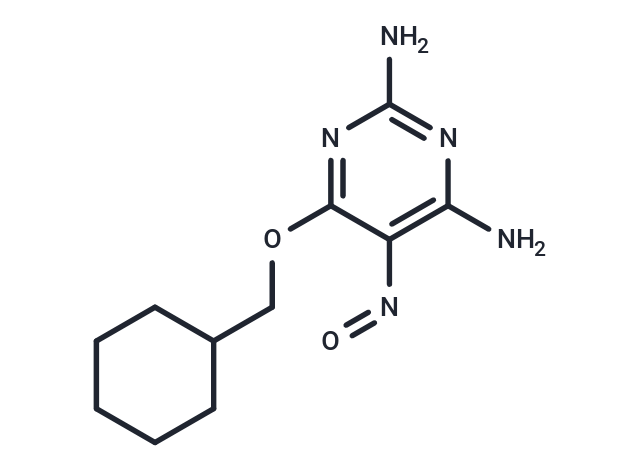Shopping Cart
- Remove All
 Your shopping cart is currently empty
Your shopping cart is currently empty

NU6027 is a potent ATR/CDK inhibitor, inhibits CDK1/2, ATR and DNA-PK with Ki of 2.5 μM/1.3 μM, 0.4 μM and 2.2 μM, enter cells more readily than the 6-aminopurine-based inhibitors.

| Pack Size | Price | Availability | Quantity |
|---|---|---|---|
| 5 mg | 35 € | In Stock | |
| 10 mg | 57 € | In Stock | |
| 25 mg | 116 € | In Stock | |
| 50 mg | 187 € | In Stock | |
| 100 mg | 278 € | In Stock | |
| 200 mg | 401 € | In Stock |
| Description | NU6027 is a potent ATR/CDK inhibitor, inhibits CDK1/2, ATR and DNA-PK with Ki of 2.5 μM/1.3 μM, 0.4 μM and 2.2 μM, enter cells more readily than the 6-aminopurine-based inhibitors. |
| Targets&IC50 | ATR:0.4 μM(Ki), DNA-PK:2.2 μM(Ki), CDK1:2.5 μM(Ki), CDK2:1.3 μM(Ki) |
| In vitro | NU6027 is soaked into crystals of monomeric CDK2 and the structure refined to a resolution of 1.85 ?. NU6027 (100 μM) inhibits growth of human tumor cells with mean GI50 of 10 μM. NU6027 causes a reduction in the number of cells in S-phase but not G1 or G2/M in MCF7 cells. [1] NU6027 is a potent inhibitor of cellular ATR activity with IC50 of 6.7 μM in MCF7 cells and 2.8 μM in GM847KD cells, and enhances hydroxyurea and cisplatin cytotoxicity in an ATR-dependent manner. NU6027 (10 μM) inhibits CDK2-mediated pRbT821 by 42% and pCHK1S345 by 70%. NU6027 significantly potentiates sensitivity of cisplatin (1.4-fold at 4 μM and 8.7-fold at 10 μM), doxorubicin (1.3-fold at 4 μM and 2.5-fold at 10 μM), camptothecin (1.4-fold at 4 μM and 2-fold at 10 μM) and hydroxyurea (1.8-fold at 4 μM) aganist MCF7 cells. NU6027 also potentiates 2 gy IR in a concentration-dependent manner and the cytotoxicity of camptothecin and temozolomide (a DNA methylating agent) at concentrations above and below their LC50. NU6027 (10 μM) attenuates G2/M arrest following DNA damage, inhibits RAD51 focus formation and increases the cytotoxicity of the major classes of DNA-damaging anticancer cytotoxic therapy but not the antimitotic, paclitaxel in MCF7 cells. NU6027 (4 μM) is synthetically lethal when DNA single-strand break repair is impaired either through poly(ADP-ribose) polymerase (PARP) inhibition or defects in XRCC1 in MCF7 cells. [3] NU6027 (4 μM) increases the proportion of cell in early apoptosis to 7.5% after 48 hours treatment in EM-C11 cells compared to 1.73% in untreated cells. NU6027 (10 μM) treatment reduces survival in XRCC1 deficient OVCAR-4 cells compared to proficient cells. NU6027 enhances cytotoxicity of cisplatin in XRCC1 deficient OVCAR-3 cells compared to XRCC1 proficient cells. NU6027 enhances Cisplatin induced DSB accumulation in XRCC1 deficient OVCAR-3 cells. [4] |
| Kinase Assay | Enzyme Inhibition Studies: Inhibition of cyclin B1/CDK1 is assayed using enzyme prepared from starfish oocytes. Inhibition of cyclinA3/CDK2 is determined using a similar assay and an assay buffer comprised of 50 mM Tris-HCl pH 7.5 containing 5 mM MgCl2. The final ATP concentration in both CDK assays is 12.5 μM, and the IC50 concentration for NU6027 is the concentration required to inhibit enzyme activity by 50% under the assay conditions used. To determine the Km for ATP for cyclin B1/CDK1 and cyclin A3/CDK2, and Ki values for NU6027, assays are performed in the absence of NU6027 and at two fixed NU6027 concentrations (5 μM and 10 μM), with ATP concentrations ranging from 6.25 μM to 800 μM. Data are fitted to the Michaelis?Menten equation using unweighted nonlinear least squares regression. |
| Cell Research | The growth inhibitory activity of the NU6027 is evaluated in the NCl in vitro cell line panel using the standard 48 hours exposure assay and NU6027 concentrations ranging from 10-9 to 10-4 M. Relationships between the profile of cell growth inhibition produced by NU6027 and that of standard anticancer agents, and the established CDK inhibitors olomoucine and flavopiridol, is investigated using the COMPARE algorithm. (Only for Reference) |
| Molecular Weight | 251.29 |
| Formula | C11H17N5O2 |
| Cas No. | 220036-08-8 |
| Smiles | Nc1nc(N)c(N=O)c(OCC2CCCCC2)n1 |
| Relative Density. | 1.53g/cm3 |
| Storage | Powder: -20°C for 3 years | In solvent: -80°C for 1 year | Shipping with blue ice. | ||||||||||||||||||||||||||||||
| Solubility Information | H2O: < 1 mg/mL (insoluble or slightly soluble) Ethanol: 3 mg/mL (11.93 mM) DMSO: 5.5 mg/mL (21.89 mM), Sonication is recommended. | ||||||||||||||||||||||||||||||
Solution Preparation Table | |||||||||||||||||||||||||||||||
Ethanol/DMSO
DMSO
| |||||||||||||||||||||||||||||||

Copyright © 2015-2024 TargetMol Chemicals Inc. All Rights Reserved.